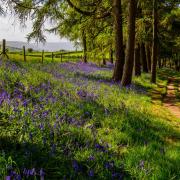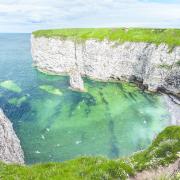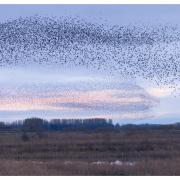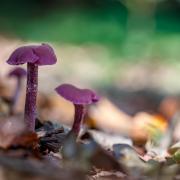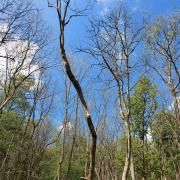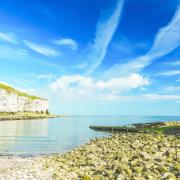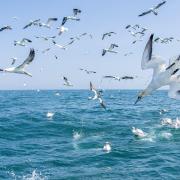Wildlife is at home in a hidden corner of East Yorkshire. Tom Marshall from the Yorkshire Nature Triangle finds out more

When it comes to attracting our most sought after wildlife, you can’t beat a bit of water. On Yorkshire’s east coast however, there’s a natural haven that has more than meets the eye, and certainly more than a bit of water.
With a length end-to-end of around two miles – rivalling that of York’s famous city walls – there’s no surprise that Hornsea Mere is the largest freshwater lake in the county, and yet this impressive Yorkshire landmark remains quietly nestled away in Holderness, waiting to be discovered.
Dominating the landscape to the west of the small town of Hornsea, the mere is part of the Wassand Estate, and has been enjoyed by residents of the Regency House at Wassand Hall since its construction in the early 1500s. The lake itself was carved by the last Ice Age, to which it owes its phenomenal size yet relatively shallow depth of around 12 feet. When originally purchased by the Constable family in the 16th century, the lake was snapped up for the princely sum of fifty pounds.
Centuries on, and despite its size, the mere only offers tantalising glimpses through the lakeside trees and swaying reeds for those who make their way into Hornsea from the west. It is this enigmatic and elusive character though, that has also allowed wildlife to flourish along the mere’s banks.

With such an expanse of open water – nearly two square kilometres – the mere has become a major stop off for birds on the great spring and autumn migration highways. From late March, early arriving hirundines like swallows and martins are no doubt thankful for the plentiful supply of insects and the chance to grab a first freshwater drink on British soil after the long migration north from Africa.
The mere’s smorgasbord of fish is also popular with other globe-trotting flyers like common and arctic terns, who find plenty to aim for along the fringes, while a real treat is the osprey, drawn by the fishing opportunities that are more typical of its usual Scottish summer haunts.
The mere’s underwater world isn’t just at threat from the air though, as the charismatic otter is another keen visitor and with all the tools to make light work of any unsuspecting fish. Now faring much better after heavy losses during the high-pollution decades of the 1970s and 1980s, otters are becoming a familiar sight across many of the region’s wetlands with Hornsea Mere no exception. On a calm day, the tell-tale ‘v’ shape of their wake is a classic sign to look out for, especially without seals or other mammals to cause confusion. Their presence though rarely goes unnoticed in the skies above and marauding gulls or other less tolerant birds will readily swoop down and harass the otters – another indication they’re in the area.
The whispering reedy fringes of the mere, broadly comprising the long thin stems and horse tail-like seed heads of Phragmites also hold plenty of secrets. The notoriously elusive bittern – a bird who seems to blend imperceptivity into this habitat – fits right in around the mere, although winter sightings are just as likely to be visitors from the continent as home-grown residents.

In recent years though, it’s another reedbed speciality that has begun to make its mark at Hornsea, the stunning marsh harrier. Like the bittern and other similar reedbed dwellers, the marsh harrier has seen a slow resurgence in numbers as reedbeds have gradually increased in area around the country and Hornsea is now as good a place as any to seek out these birds of prey.
While the female offers a relatively uninspiring chocolate brown plumage, the male’s golden streaked, silvery wings and black wing tips leave little doubt it is the king of the reeds. It’s the extravagant mealtimes however, when marsh harriers really show their status. As a ground nesting species – relatively unusual among birds of prey – the female harrier and the male in particular risk giving away the location of their nest to would-be predators of their valuable eggs or young chicks. That’s why when it comes to getting the rewards from the latest hunting trip back home, the harriers opt for a dramatic mid-air handover, or ‘food-pass’. After a brief confirmation that dinner is indeed on the table, the pair will synchronise a perfect toe-to-toe swap of their quarry well above the reeds – and crucially away from the nest – before the female discretely returns to her hungry family.
Away from the mere, a small woodland adjacent to Wassand Hall offers plenty more to investigate beneath your feet. Warmer mornings in spring find non-venomous grass snakes basking in the sunlit glades, a real treat with their black diamond-covered backs, and yellowy-green scales.
Butterflies also find plenty to enjoy in the sunbeams including woodland specialities like brimstone and speckled wood. If the mere’s summer soundtrack is the rhythmic, if sometimes haphazard song of the reed warbler or the deafening burst of the cetti’s warbler, then the woods echo to drumming great spotted woodpeckers and the laughing ‘yaffle’ of the green woodpecker.

Later in the year when winter tightens its grip, the mere’s large size means when other areas become locked in ice, open water is still on offer for birds like whooper swans en route from the Arctic circle or the striking goldeneye, with males in January and February often indulging in their seemingly neck-breaking mating displays. Such proximity to the unforgiving North Sea can also find species more familiar with the offshore surf flying in for shelter, including long-tailed ducks, great northern divers and Slavonian grebes.
So whenever you visit Hornsea, from a ‘mere’ fifty pounds nearly five centuries ago you can be assured of a great value wildlife experience today.
Where to go
Wassand Hall and Estate is off the A1035 just east of Hornsea, where you can take the woodland trail (around 30 minutes each way) and visit a specially constructed hide built by the estate’s own craftsmen overlooking the mere – where otters and marsh harriers are often seen. There is a charge of £2.50 per person which contributes to the preservation of the hall and gardens, and tickets are available at East Lodge at the estate entrance (look out for the white signs). An entry code is required to use the viewing hide.
Access to the eastern shore of the mere is possible from Southgate in Hornsea, including the café and sailing club, but please note opening times may vary. This area is more suitable for those wanting to feed the waterfowl, or for a wider view back west of the mere itself. For more information go to wassand.co.uk.
Hornsea Mere is one of a series of locations that form the ‘Yorkshire Nature Triangle’, stretching from Filey in the north to Spurn Point and across to the Yorkshire Wolds.
For more on the area and the wildlife that can be found there visit yorkshirenaturetriangle.org.uk




